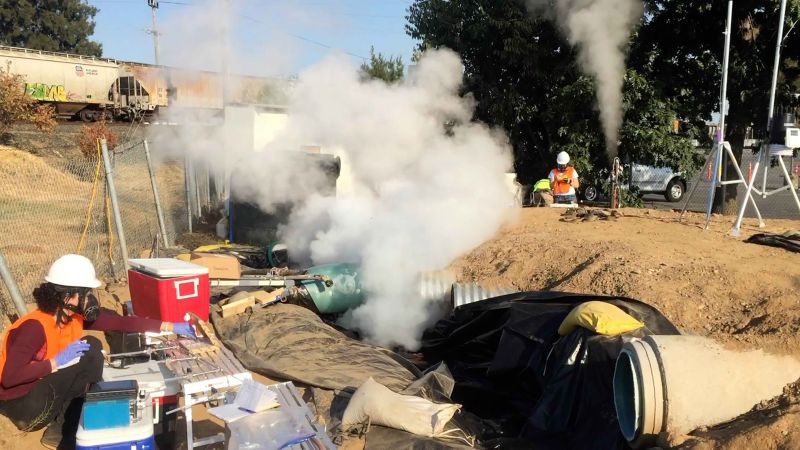Materials Emitted by CIPP May Pose Health Risks
Published on by Water Network Research, Official research team of The Water Network in Academic
New research is calling for immediate safeguards and study of a widely used method for repairing sewer, storm-water and drinking-water pipes to understand the potential health and environmental concerns for workers and the public.

Purdue researchers perform testing during a CIPP installation. (Purdue University photo)
The procedure, called cured-in-place pipe repair, or CIPP, was invented in the 1970s. It involves inserting a resin-impregnated fabric tube into a damaged pipe and curing it in place with hot water or pressurized steam, sometimes with ultraviolet light.
The result is a new plastic pipe manufactured inside the damaged one. The process can emit chemicals into the air, sometimes in visible plumes, and can expose workers and the public to a mixture of compounds that can pose potential health hazards, said Andrew Whelton, an assistant professor in Purdue University's Lyles School of Civil Engineering and the Environmental and Ecological Engineering program.
He led a team of researchers who conducted a testing study at seven steam-cured CIPP installations in Indiana and California. The researchers captured the emitted materials and measured their concentration, including styrene, acetone, phenol, phthalates and other volatile (VOC) and semi-volatile organic compounds (SVOC).
Results from their air testing study are detailed in a paper appearing on July 26 in Environmental Science & Technology Letters.
Findings show that the chemical plume, commonly thought of as harmless steam, was actually a complex mixture of organic vapor, water vapor, particulates of condensable vapor and partially cured resin, and liquid droplets of water and organic chemicals.
"CIPP is the most popular water-pipe rehabilitation technology in the United States," Whelton said. "Short- and long-term health impacts caused by chemical mixture exposures should be immediately investigated. Workers are a vulnerable population, and understanding exposures and health impacts to the general public is also needed."
New Research Results
The researchers have briefed the National Institute for Occupational Health and Safety (NIOSH) about their findings. NIOSH is part of the Centers for Disease Control and Prevention and has occupational safety and health experts who can investigate workplace hazards.
Purdue researchers captured the chemical plume materials from two sanitary sewer-pipe installations and five storm-water pipe installations. Samples were analyzed using gas chromatography, thermal and spectroscopic techniques. Chemicals found included hazardous air pollutants, suspected endocrine disrupting chemicals, and known and suspected carcinogens. Emissions were sometimes highly concentrated and affected by wind direction, speed and the worker's activities, Whelton said.
A waxy substance was found in the air, and materials engineers determined it was partially cured plastic, styrene monomer, acetone, and unidentified chemicals.
No respiratory protection was used by CIPP workers, and a review of online videos, images and construction contracts indicates respiratory safety equipment use was not typical, he said.
To evaluate chemical plume toxicity, pulmonary toxicologist and assistant professor Jonathan Shannahan and a graduate student exposed captured materials to mouse lung cells. Plume samples from two of four sites tested displayed toxicity effects and two did not.
"This suggests that there are operational conditions that may decrease the potential for hazardous health effects," Shannahan stated. "Since exposures can be highly variable in chemical composition, concentration, and exposure duration our findings demonstrate the need for further investigation."
At the same time, existing testing methods are not capable of documenting this multi-phase chemical exposure, Whelton said.
Read more: Science Daily
Attached link
http://www.youtube.com/embed/rBMOoa2XcJIMedia
Taxonomy
- Public Health
- Leakage Detection
- Infrastructure
- Infrastructure Management
- Utility Pipe Network
- Public Health
- Pipes and Pipelines